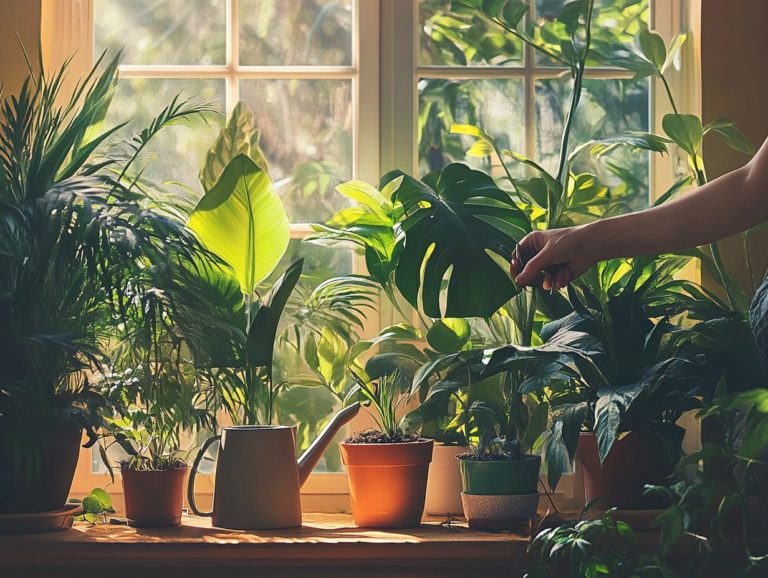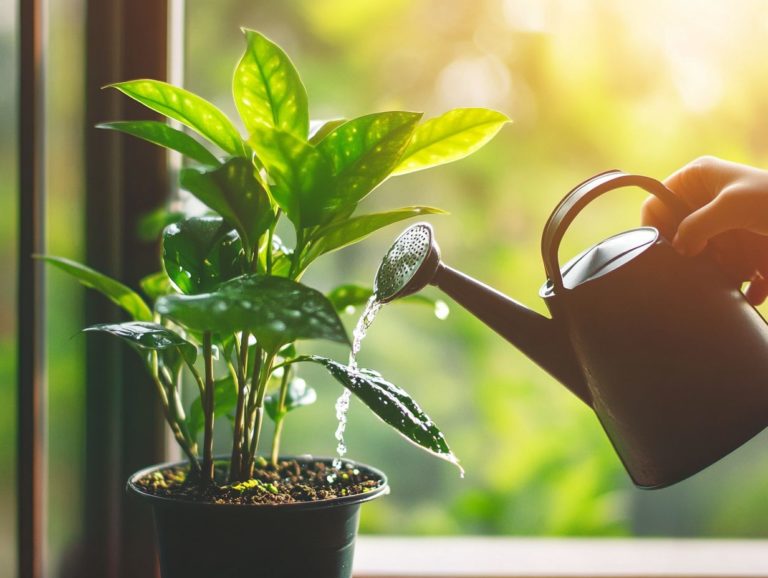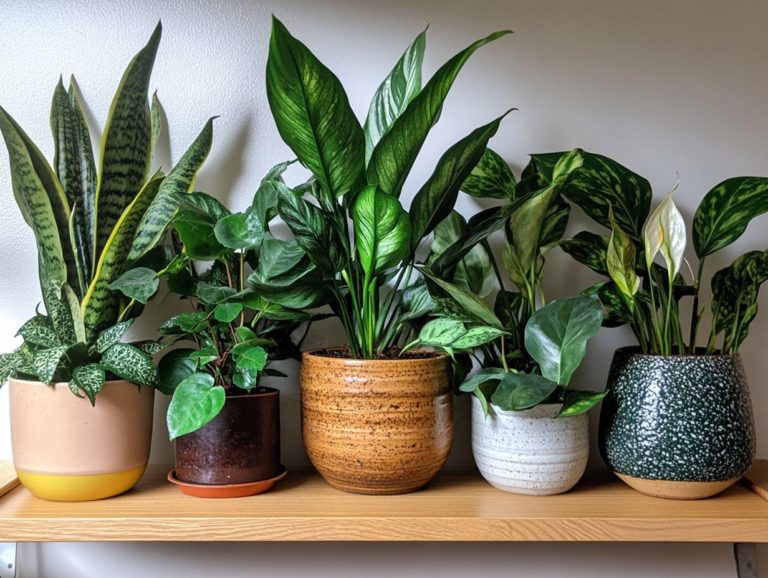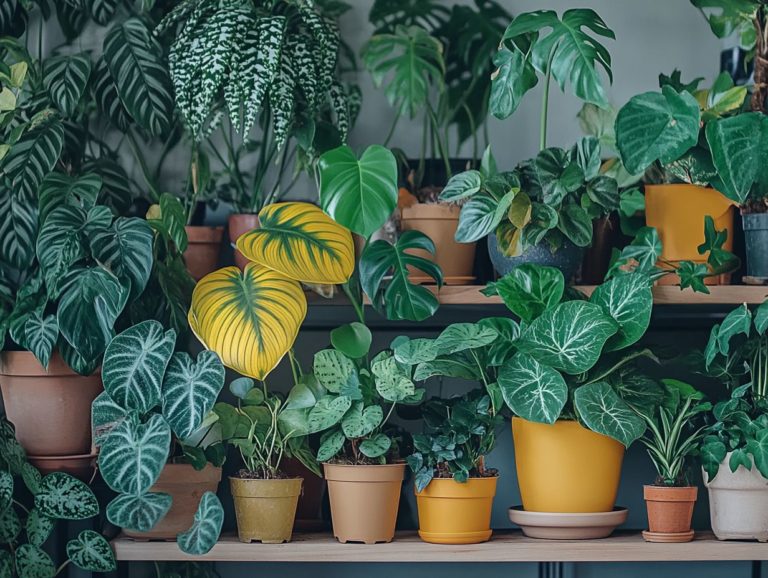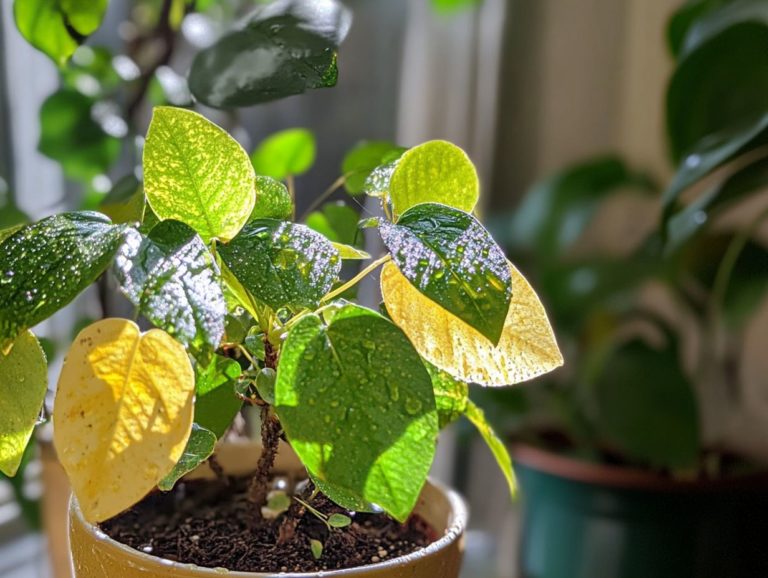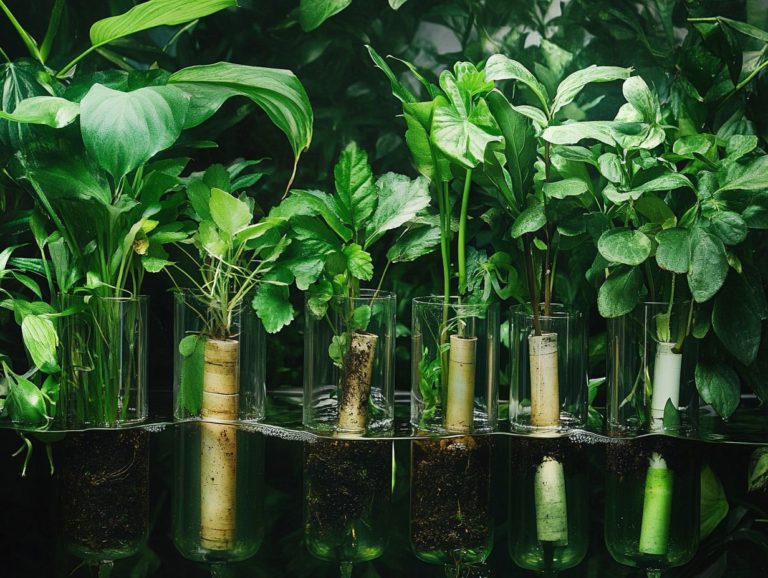What is the Best Indoor Plant for Beginners?
Indoor plants, including popular houseplants like succulents and the heartleaf philodendron, have become increasingly popular due to their many benefits that enhance your living spaces and overall well-being.
These green companions do more than just look good; they purify the air and even boost your mental health, making them essential for beginners in their plant care journey. If you re starting out in the world of gardening, selecting the right houseplants and knowing how to care for them can feel overwhelming.
This guide is designed to help you choose easy-to-grow options, provide essential care tips, and highlight common pitfalls to avoid. This way, your indoor gardening journey, especially as a beginner, will be enjoyable and rewarding.
Contents
- Key Takeaways:
- Benefits of Indoor Plants
- Choosing the Right Indoor Plant
- Easy-to-Grow Indoor Plants for Beginners
- Caring for Indoor Plants
- Common Mistakes to Avoid
- Frequently Asked Questions
- What are some beginner-friendly indoor plants?
- What is the Best Indoor Plant for Beginners?
- What are some other easy-to-care for indoor plants for beginners?
- Do I need to have a green thumb to take care of indoor plants?
- What are some common mistakes that beginners make when caring for indoor plants?
- Are there any indoor plants that can purify the air in my home?
- How often should I water my indoor plants?
Key Takeaways:
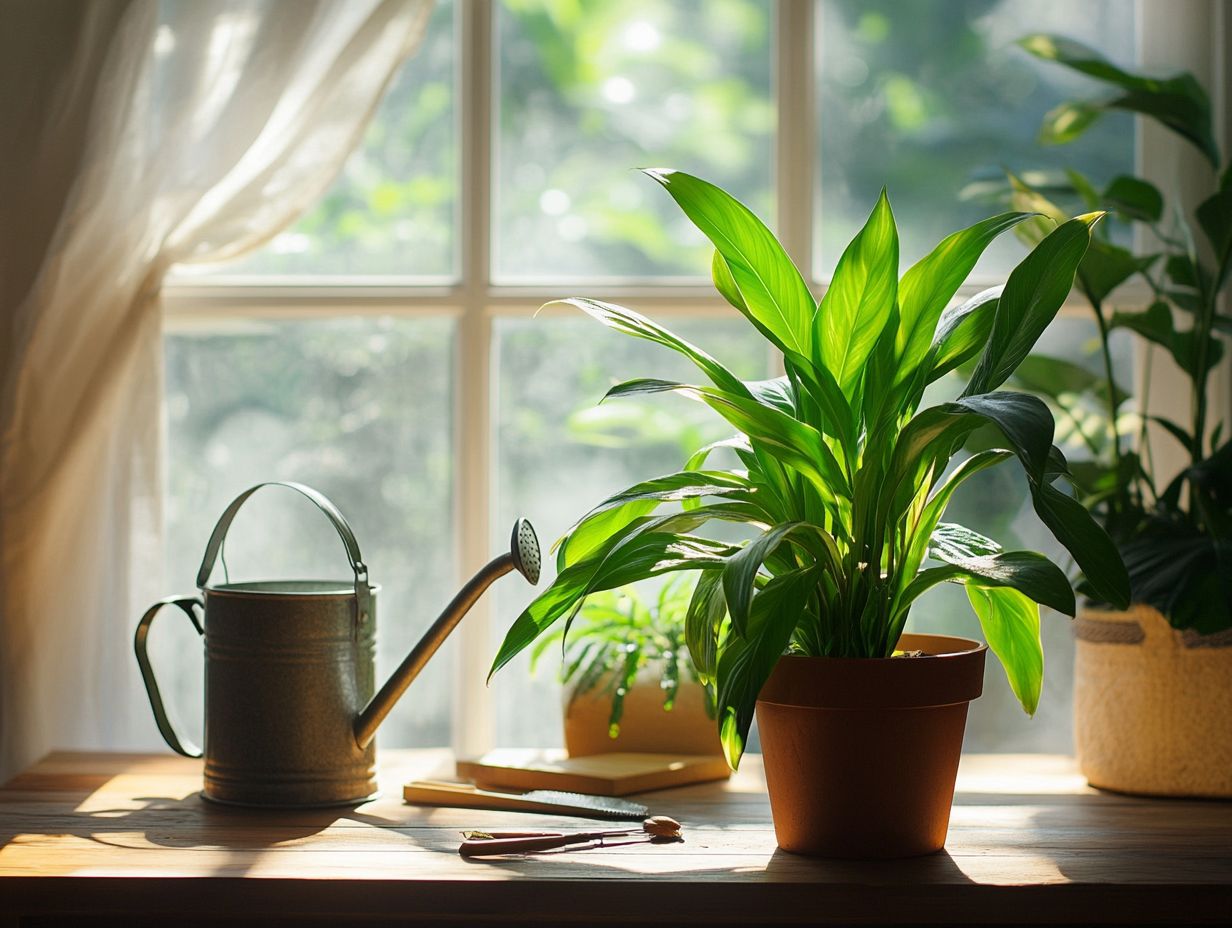
- Indoor plants not only enhance your home s look but also purify the air and improve mental health.
- Consider light, water, and humidity when choosing plants.
- Some easy-to-grow indoor plants for beginners include pothos, spider plants, and peace lilies, which are forgiving and thrive in low light.
Benefits of Indoor Plants
The benefits of indoor plants extend beyond just looking good; they play a crucial role in enhancing your quality of life. Imagine breathing in cleaner air and boosting your mental well-being.
Many popular houseplants, like the heartleaf philodendron and pothos (also known as Epipremnum aureum), are low-maintenance and thrive in various light and moisture conditions, making them perfect for your plant-care journey.
Community gardens and food justice initiatives show how plants contribute to vibrant green spaces. They provide tranquility and foster social connections.
Air Purification and Mental Health Benefits
Indoor plants are more than mere d cor; they are essential allies in air purification and enhancing mental well-being. By filtering out toxins and creating a calm environment, these resilient plants significantly elevate your living space.
For example, the ZZ Plant, Snake Plant, and Aloe Vera excel at removing common indoor pollutants, leading to cleaner air, which is vital for your plant health and overall well-being. Welcoming them into your home enhances aesthetic appeal and fosters a calming atmosphere that promotes relaxation and focus.
The presence of greenery, especially leafy plants, has been shown to reduce stress and anxiety, highlighting the connection between plant vitality and emotional resilience. Choosing non-toxic options like the Spider Plant transforms your indoor space into a safe and rejuvenating sanctuary.
Choosing the Right Indoor Plant
Selecting the ideal indoor plant can be both a gratifying and formidable endeavor, particularly for beginners. Consider factors like light conditions and the amount of moisture in your home, along with the varying maintenance needs of different plant varieties.
Some plants, like the heartleaf philodendron (Philodendron hederaceum), are forgiving, while others, like the Fiddle Leaf Fig, require more attention. Thankfully, many low-maintenance plants are available at local plant clubs, making it easier to start your indoor gardening journey.
Factors to Consider for Beginners

When selecting indoor plants, consider several critical factors. These include the plant’s watering needs, its tolerance for humidity in your home, and the specific growing conditions ideal for your environment.
Understanding these care needs is essential for ensuring that your indoor greenery especially common houseplants thrives instead of withering away. If you don’t quite have a green thumb, opting for low-maintenance options like succulents, including the Moon Cactus, and tropical plants can truly be a game changer.
These forgiving plants are perfect for novices. They generally require less frequent watering and can adapt to varying humidity levels with ease. By choosing the right plants, including fast-growing varieties, you can create a vibrant indoor garden that enhances your living space while minimizing potential frustrations associated with plant care.
Easy-to-Grow Indoor Plants for Beginners
As you embark on your journey into the world of indoor gardening, choosing easy-to-grow plants can pave the way for a seamless introduction to plant care. This approach makes your experience enjoyable and stress-free.
Among the houseplant recommendations, you’ll find beloved options like the heartleaf philodendron and pothos. Both are celebrated for their low-maintenance nature and knack for thriving in diverse conditions, making them perfect for anyone passionate about small-space gardening.
Top Picks for Low-Maintenance Plants
Consider some of the top low-maintenance indoor plants that can effortlessly elevate your space: the heartleaf philodendron, pothos, ZZ Plant, and Snake Plant. Each one brings its unique charm and easy-care traits.
These plants not only enhance your environment but also thrive with minimal attention. They are ideal whether you’re a seasoned gardener or just starting out, especially with the help of gardening tips. The heartleaf philodendron, with its vibrant leaves and elegant trailing vines, prefers indirect sunlight and only needs watering when the soil feels dry.
Similarly, pothos, known as Epipremnum aureum, is incredibly forgiving and can adapt to various light conditions with ease. The ZZ Plant is a testament to resilience, flourishing even in low light and needing infrequent watering, making it a favorite among houseplant enthusiasts.
Let s not forget the Snake Plant, renowned for its striking upright leaves. It can go weeks without a sip of water, showcasing its low maintenance appeal. Collectively, these options allow you to cultivate a vibrant indoor garden filled with resilient plants that enrich your home without demanding excessive time or effort.
Caring for Indoor Plants
Caring for indoor plants means grasping their specific needs, particularly regarding soil moisture, watering requirements, and humidity levels. These can differ remarkably across various species, including fast-growing and easy-to-care varieties.
For those just starting, mastering these fundamental tips can significantly boost plant health and longevity. You can transform your indoor space into a flourishing green sanctuary filled with thriving houseplants.
It’s essential to monitor factors like light conditions and soil moisture. Ensure your plants receive the attentive care they deserve without the risk of overwatering or neglect, which are common gardening challenges.
Essential Tips for Plant Care
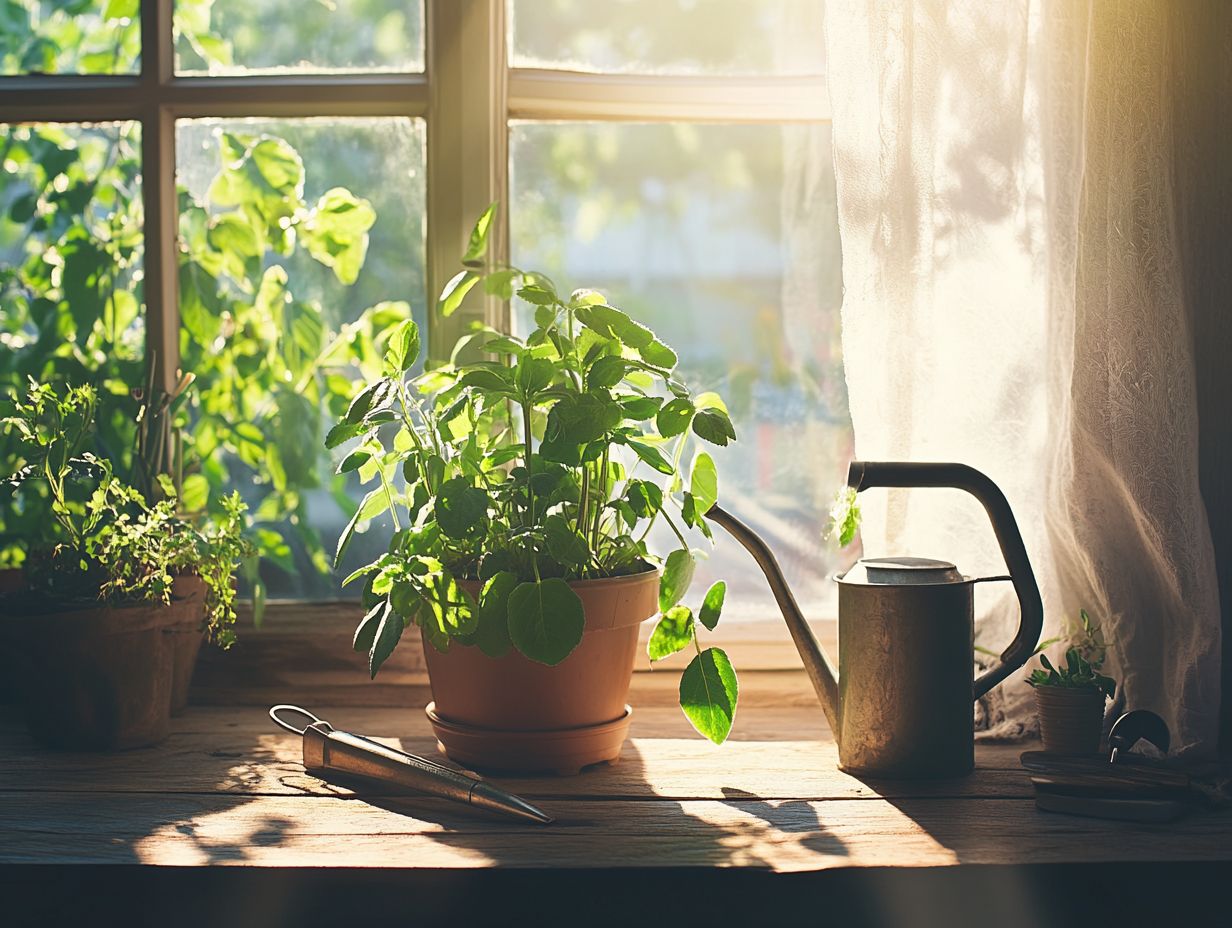
To care for your plants effectively, know their specific watering needs and ideal light conditions. Understand each plant’s unique traits, including those of native varieties, to help them grow their best!
Paying close attention to these factors can transform your plant care game! For example, some plants, like the Fiddle Leaf Fig, flourish in bright, indirect sunlight, while others, like the Cast Iron Plant, are happiest tucked away in shady corners.
Regularly monitoring soil moisture not only helps you determine the ideal watering frequency but also prevents overwatering, which can lead to root rot and decline in your indoor plants health. It’s equally vital to routinely check for pests that could endanger your plants; early detection can truly make a significant difference in maintaining healthy indoor plants.
Ultimately, adjusting your care routines to reflect these needs will enhance your plants’ growth and vitality, especially for forgiving plants. Imagine a thriving indoor garden right in your home!
Common Mistakes to Avoid
In indoor gardening, steering clear of common mistakes, such as overwatering and neglecting light conditions, is crucial for safeguarding your plants and fostering a vibrant, green oasis.
Many beginners find themselves grappling with issues like failing to monitor soil moisture levels and positioning affordable plants in less-than-ideal lighting conditions. These mistakes can lead to unnecessary stress for your cherished houseplants.
Learn about potential pitfalls to improve your gardening and enjoy a fun and rewarding time gardening indoors, especially through the use of easy propagation techniques.
How to Prevent Plant Damage
To prevent damage to your indoor plants, especially common houseplants, it’s essential to grasp their unique watering needs and ideal light conditions, which can vary significantly among different species. Each plant flourishes in its distinct environment, making it vital for you to research specific requirements, such as the ideal humidity levels and soil moisture.
For example, succulents generally thrive in bright, indirect sunlight and prefer infrequent watering. In contrast, leafy tropical plants, including varieties from community gardens, often crave more humidity and consistent moisture.
A common pitfall many plant owners encounter is overwatering, which can lead to root rot, or placing a shade-loving plant, like the Chinese Evergreen, in direct sunlight, resulting in unsightly leaf scorch.
By observing your plants regularly and adjusting their care according to their individual needs, you have the power to cultivate a vibrant indoor garden filled with thriving indoor plants that enhances your living space and brings it to life.
Frequently Asked Questions
What are some beginner-friendly indoor plants?
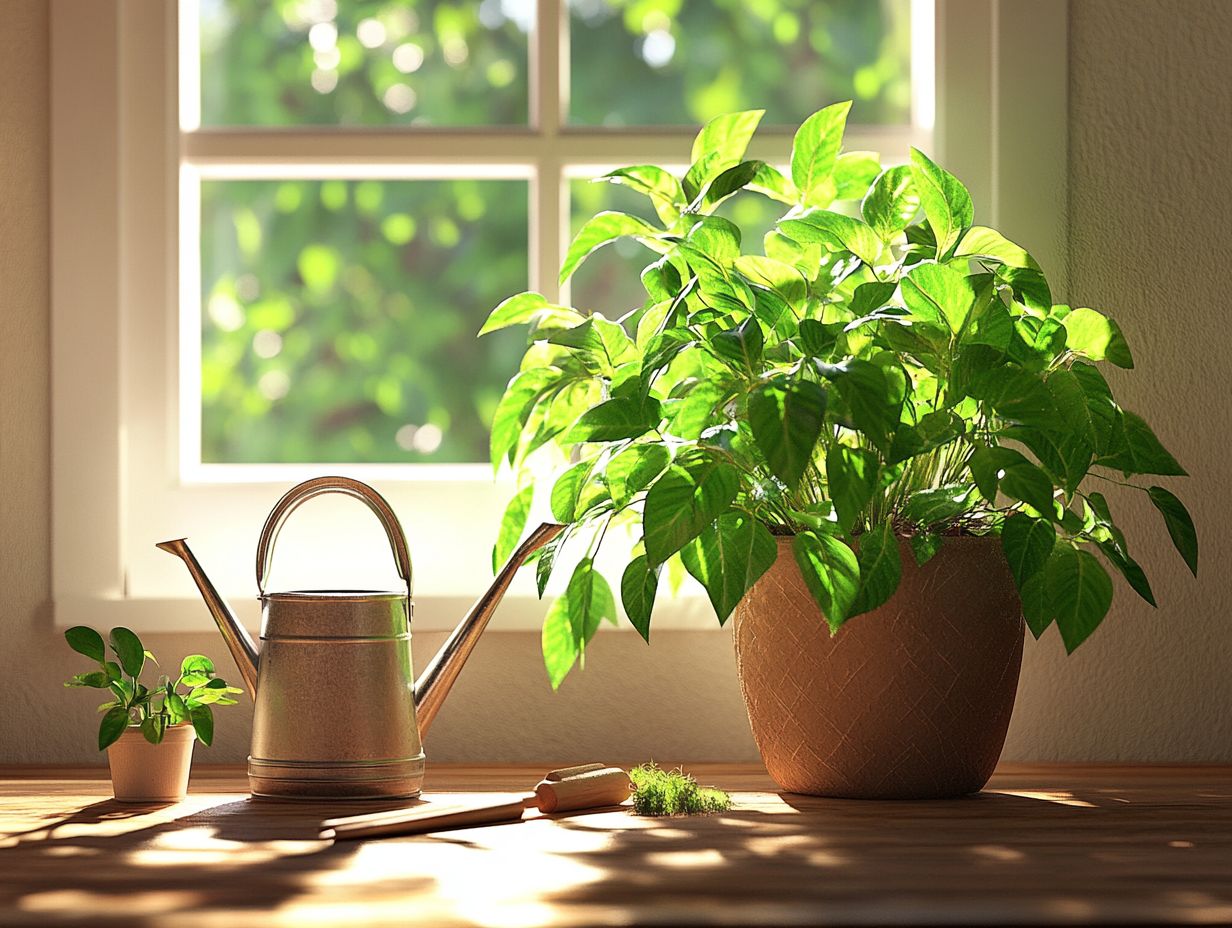
What is the Best Indoor Plant for Beginners?
Some of the best choices include forgiving plants like the heartleaf philodendron, pothos, and ZZ Plant, which are easy to care for and perfect for novices!
The best indoor plant for beginners is the pothos plant (Epipremnum aureum). It is low-maintenance, easy to care for, and can thrive in a variety of light conditions. If you’re considering getting one, check out what to look for when buying indoor plants to ensure you make the right choice.
What are some other easy-to-care for indoor plants for beginners?
Some other great options for beginners include the spider plant, the snake plant, and the peace lily. These common houseplants are all hardy and can tolerate a range of conditions.
Do I need to have a green thumb to take care of indoor plants?
No, you don’t need to be an expert gardener to successfully care for indoor plants. Many plants, such as the pothos and spider plant, are forgiving plants and can thrive even with minimal attention. This makes them great for beginners.
What are some common mistakes that beginners make when caring for indoor plants?
Overwatering and placing plants in direct sunlight are common mistakes beginners make. Researching the specific needs of your plant is essential.
Are there any indoor plants that can purify the air in my home?
Yes! Plants like the snake plant, spider plant, and peace lily can improve the air quality in your home.
How often should I water my indoor plants?
Watering frequency depends on the plant type and its environment. Generally, it s better to underwater than overwater.
Check how wet the soil is before watering. Understanding how much water your plant needs is crucial for its health.

